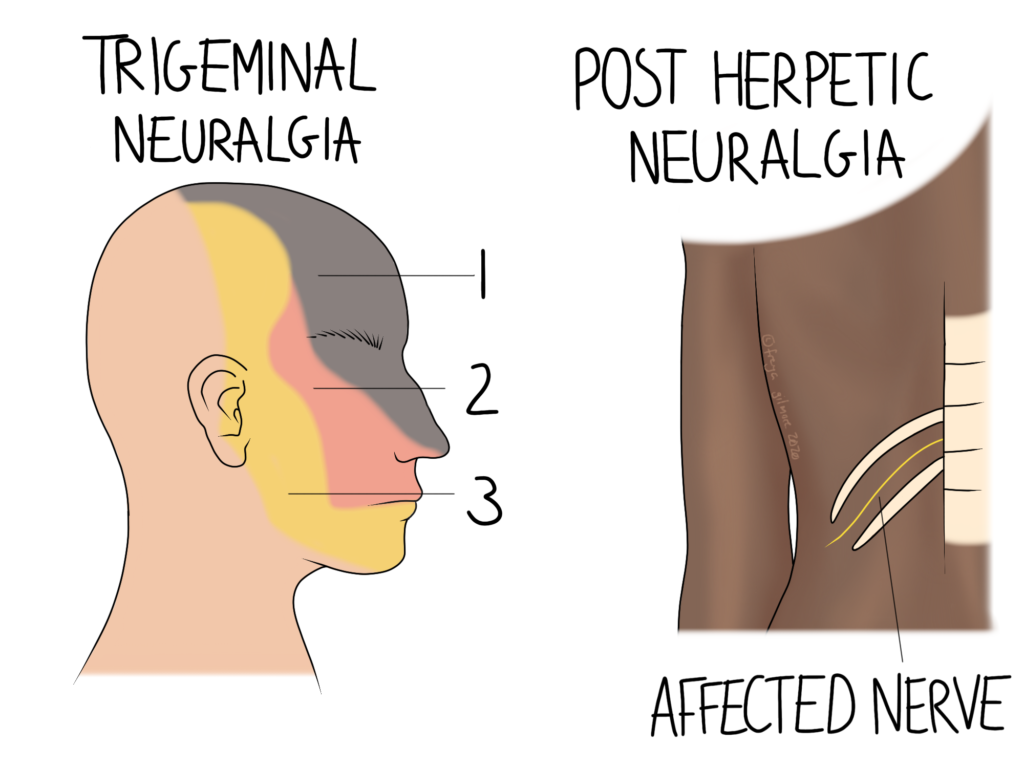The word “neuralgia” literally means “nerve pain”, but we use the term more specifically. Although sciatica is pain and other symptoms in the sciatic nerve, we wouldn’t call it a neuralgia. Sciatica involves compression or irritation of a nerve, rather than the damage or inflammation causing neuraglic pain. These problems can be caused by infection, disease, or trauma. But sometimes the root cause is not clear. In terms of symptoms, expect neuralgic pain to follow the line of a nerve, and to be sharp, intermittent, and severe. The ASA recognises neuralgia as a condition within an osteopath’s remit.

Types of Neuralgia
Trigeminal Neuralgia
Trigeminal neuralgia (TN) is a specific type of neuralgia that affects the trigeminal nerve. This nerve is so named as it splits into three branches to supply sensation to the face, as illustrated above. Typically TN just affects one branch at a time. The condition is known for its severe, sudden, and stabbing facial pain that can be triggered by very mild stimuli, such as brushing teeth, chewing, or even a breeze on the face. The pain is often described as electric shocks or burning sensations and can last from a few seconds to several minutes at a time, significantly affecting the individual’s quality of life.
Trigeminal neuralgia is more common in women and individuals over 50. Its exact cause is often related to compression of the trigeminal nerve by an adjacent blood vessel. Other possible causes include neurological diseases such as multiple sclerosis (MS). Diagnosis of TN is primarily clinical, based on the patient’s description of symptoms and neurological examinations. Treatment options include medications such as muscle relaxants to help stabilise nerve activity. In more severe cases, surgical procedures may be appropriate, either to remove the pressure from the nerve or to change the way the nerve processes pain.
Neuralgia from Shingles
Another common form of neuralgia arises from shingles, known as postherpetic neuralgia (PHN). Shingles is a viral infection caused by the varicella-zoster virus, the same virus that causes chicken pox. After initial exposure to the chicken pox virus, it lies dormant in nerve tissue. If it reactivates, which can happen many years later, it causes shingles. Shingles causes a painful rash, similar to chicken pox, which tends to follow the course of a nerve, often between the ribs. The area can then develop PHN, where the throbbing or burning pain persists after the rash has healed.
The risk of developing PHN increases with age, and it is more common in the over 60s. The pain results from nerve fibres damaged by the infection, which send amplified pain signals to the brain. Treatment for PHN focuses on managing pain and improving the patient’s quality of life. Topical or oral painkillers are first line medication options, with steroid injections appropriate for some more persistent cases.
Osteopathic Treatment
Alongside treatments deemed appropriate by your doctor, osteopathy may be able to help with desensitisation of the affected nerve. During your appointments, we can gradually increase the application of stimuli to the sensitive area. This can be continued at home through specific exercises. These techniques aim to retrain the brain to accept that these stimuli are not painful, slowing bringing down the increased pain response over time.
Click here to book an appointment with Beverley for your neuralgia.
